![]()
![]()
![]()
Use LEFT and RIGHT arrow keys to navigate between flashcards;
Use UP and DOWN arrow keys to flip the card;
H to show hint;
A reads text to speech;
28 Cards in this Set
- Front
- Back
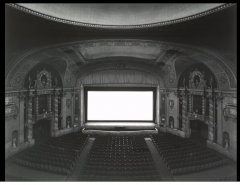
|
Hiroshi Sugimoto, U.S. Walker, New York 1978 Spectacle Photographer, New York and Tokyo Studios Work deals with Media/ Connected to media and spectacle in practice large format photography and subject matter, theater. interested in photography as a practice, something that can portray reality, is objective and truthful, also photography a intangible ephemeral practice, how photography deals with abstract notions of reality, tension as abstracted approach to reality and reality hiroshi always works with large format photography using an 8x10 camera. used early photographic technologies with complex exposure times front and back of camera move seperately allowing more precise photos. Shots set up, a lot of work to create photograph 33-34 images of movie theaters. situates camera to only have light exposure from film that is playing. leaves the apature wide open is a light based spectacle but is also important for the photo to exist. high degree of detail |
|

|
aerial view of st peters basillica vatican rome italy 1506-1666 Classical ballance and symetry counter reformation and spectacle rebuilt from 4th c basilica 1506 started to re build 1546 michelangelo re planned the basilica 1607 expanded with roman architecture, open courtyard like mosques. pagan and islamic traditional structural elements, connect to counter reformation ideals piaza of 4 collumn deep collinades are added covered colinades frame piaza bernini was sculptur and architect st peter's the seat of papacy pope adresses people who gather in piaza and blesses them, rituals take place in piaza 120 thousand people can be grouped in space pope paul 5th gave comission to bernini to build arms of church, hold the faithful together response to reformation. a demonstration of awe and oppulance of catholic church bernini trained as a painter from a family of artists out side of rome 1598 birth egyptian obelisqu in center of piaza was 1000 years old and collinade was framed around it. collinade has classsical temple front classical language broken down to be expressive splendor and spectacle
|
|
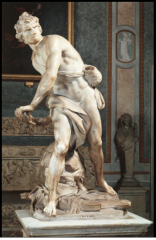
|
Bernini, David, 1625 spectacle, baroque Same narative as other david, fells the giant with a small stone and sling shot. an old testament narrative where david saves the israelites takes giants own sword and cuts off head high classical ideals from renaissance contrasts with bernini's high drama baroquian david. Goliath the giant bernini shows david mid action, body torqued, look on face consternation, about to fell goliath action and drama in bernini's and qualities of baroque. highly realistic, but als o includesviewer in the drama. Emotional connectivity and conection to counter reformation and excitement of sculpture. audience is meant to feel the narative
|
|

|
Bernini, Cornaro Chapel, Church of Santa maria della vittoria, Rome, 1645-52 Extacy of Saint Teressa private chapel designed by bernini on short end of cross, on tancept. located in santa maria della vittoria, bought by cornaro family, they could do ritual services in space others had to stay outside ballistrade. Bernini was working with a viewer outside and within ballistrade Bernini designed architecture to work with the chapel. Designs program of floors and sculptures. Urban the 8th's death results in bernini's decline, he starts doing comissions for families. Coranaro familu comissioned this one and then donated it to this church. asked for main sculpture to be st terissa of avelia in the contract . They didint pick the moment of narrative until later discussions with bernini. Cornaro argued for 8 members of the cornaro family's portrait busts to be included in the comission. 4 on either side. bernini made a recessional nich in the walls where the busts sit. Is a decorative program, theatrical program with spectators built in. Counter reformation cultural production is important. St teresa carmelite reformer. in early part of reformation, was someone with many visions of christ and relationship to god. and wrote about it writtings were international best sellers, very popular. sculpture shows vision where angel of god appeared to her, very impressive sculptural detail in veil and cloud. Angel holding a long golden spearand at the iron tip is a tip of fire, pierced her hart several times so it penetrated her entrails when he drew it out she thought he was drawing them out with it, he left her a fire with complete love of god. metaphor for a sexual experience of st taresa the extacy of st taressa, is about sex a physical conversion, emotion and bodily senses and pleasure deep ressesional space in nichs bernini connects to classissim but drapery all over and details make it beroquian Affect, spectacle, counter reformation |
|

|
Demonstrates conversion of st paul. a follower of christ not an apostle a centure and a half after christs life. a roman solder who was supposed to root out those of the christian faith and persecute them. Paul stuck drown from horse by great light. "saul saul why have you forsaken me" moment of conversion to christianity. jesus sais i am jesus who ou are persecuting, Sizing of composition, most of image is horse's ass. figure paul is on his back moment of blinded, servant looking down at him. viewer is present at conversion part of the moment. theatrical the scene exists with viewer. Scale used by carvaggio. narative deviates from typical representation of holy figures. Convices viewer of physical reality of the scene, the use of high contrast lighting, and its conection to chapel space and light in chapel. like you are actually watching the scene take place
|
|
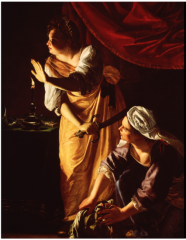
|
Artemisia gentileschi, judith and her maid, C 1625 series, unusual because she is a female artist, was recognized in her day as an artist. couldnt travel freely, coulnt roam city at night for subjects etc. father was an artist, had access to art from a young age. refused to paint acceptable scenes for a woman to paint. women wernt to do history painting. that was all she painted with the exception of self portraits. works recognized as significant. judith and maid, a story from book of judith, an isrealite, hebrew and palistinian relationship, palestine seiging a jewish city bethulia where judith is from. send judith to the guy to save city. holifernais tent is accessed by judith and maid who kill him by cutting his head off. back ground of image is blackness. the moment is baroquian. the contrast of the light promotes moment in narrative. image about the difficulties of female artists and her own personal struggles with unequal power.
|
|
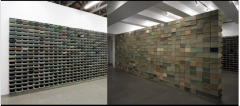
|
Dan Peterman, 4 Ton vertical Storage, 1996 The everyday, concernced with ecology, how do we connect to one another and our environment practices adaptive reuse. takes an old objects or sites, and repurposes them. subject is issues around sustainability. completely made of reused plastic interlocking hollow units grid of almost 1300 containters uses containters to chart plastic consumption, 24 bins are the average consumption of one person in north america. 54 years of plastic use by one individual. draws attention to everyday issue of consumption.
|
|

|
everyday jan steen, Celebrating the birth, 1664 genre scene painter, everyday life was his most painted theme. very prolific painter 800 paintings, 350 survive today. chaotic view of everyday life. a jan steen house is a crazy scene of a house. coded scenes, with lots of meaning. center has father holding a baby, mother is seated on the side. gender inequality, shown. birth of a son a party, a girl was not a celebrated as much. as men could work and women could not, be ecenomic generators. many women gathered, a mesy chaotic house. figure in the back appears to be delivering goods. the male figure in back is holding up two fingers, a gesture to mark the father as celebrating a child that may not be his. it is playful and a simple suggestion. is coded with inuendo of morality tale for the viewer to consider. all the prioritization demonstrates a space within the scenes for other questions or tensions of the middle class everyday.
|
|
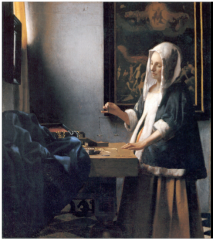
|
everyday johannes vermeer, woman with a balance, c 1664 solitary figure with direct source of light, shown in profile doing a mundane everyday task. this is a reocuring set up for vermeer. self taught. became part of artist guild. considered an established painter by peers. didnt make a lot of paintings, evidence of 35 paintings. would often make art and not want to sell it. made a living as a dealer. turned house into a space to show artists works. mostly set in his house. and often same people, women who worked for him often as they were ready models. artist considered viewer when painting as shown by details and vagueness, showing where the viewer should look, with a high level of mindfulness. measurin materials on a small scale. caught in mid action. genre paintings are often laden with meaning. the scale and last judgement conection, on back wall is a painting of a last judgement scene, with a christ figure. vermeer was catholic, unlike most of dutch republic, created difficuly for him as an artist as some of his images have catholic connotations. used mirrors and camera obscura for areas of focus where he wanted more focus.
|
|
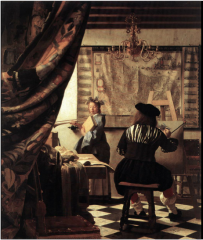
|
everyday johannes vermeer, the art of painting 1666-70 is a self portrait, shows artist, and is an allegory of painting. shows another of items that are a little out of place. the chandelier and the tile floor would normally be in public areas of the house. he is shown painting the feathers of the headdress of a woman, the woman is a personification of painting itself, a reference to Repa's writings, the map is very clear and focused, can even read the map. there is a rip in the map, could be a reference to the north and south devision of religion, on the chendelier there is a two headed lion, the symbol of the former rulers of holand, again another reference to his catholosism. the curtain is baroquian it situates the viewer in the scene |
|
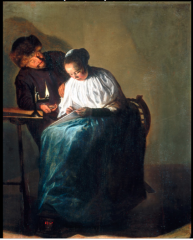
|
Everyday judith leyster, the proposition, 1631 had a thriving career as a portrait artist. and depicting genre scenes. studied with franz hall who's work ended up being conected to him. she had 5 children and was married, the husband took care of the kids and she earned a very good living. genre scene, that holds additional meaning. older man has a hand full of coins, holding it up to a younger woman. she is not aknowledging him, her suiter. the man has a red nose and face, maybe has been partying, and he propositions her, she is not interested. it is an unusual scene, she is a symbol of domestic decorum. |
|

|
jean-antoine watteau, the pilgrimage to cythera 1717 rococo the everyday cythera is the island of venus, where venus lived rococo, important parts are in the picture plane of the image, nothing in the back ground. the foliage and the clothing is all curled and shell like or stone like cupids, the son of venus, on the left all the people are ambiguous in movement, coming or going. everyone is coupled. couples are talking or in amerous way allow to project viewer into the space, a playful image the rococo is bought by upper class french, witty playful images
|
|
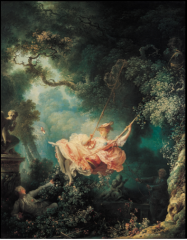
|
jean-honore fragonard, the swing, 1766 student of bucher shell like formal arrangement of the landscape shows amerous relationship a narrative the viewer can get lost in image of woman swining a member of aristocracy known by dress figure in back pulling ropes has a colar and is a member of the cleargy she is kicking her shoe off the cupid is holding his finger up "shh" her boyfriend is down below looking up, looking up her skirt, hand is out stretched pointing up her skirt painting about sex intrigue painting where the viewer is lost in narrative not a grand narrative, is simply about play, mystery imagination, not great historic or religeous narratives rococo demonstrates excesses of aristocracy "the enlightenment" |
|

|
angelica kauffmann, cornelia, mother of the gracchi 1785 neoclassisism replaces rococo, closer inlign with enlightenment values neoclassisism draws inspiration from ancient antiquity, tends to de emphasize back ground cornelia, married to roman statesmen, was very celebrated as virtuous, had 12 children 3 survived, daughter and two sons cornelia's husband dies as a political reformer she remains a widow, raises the kids and educates them by greek and roman scholars raises boys to be political reformers from upper class but do not listen to class, are more into the people, not conservative togas, classical dress, columns, plasters, clearly grided floor cornelia is holding the daughters hands, educating the children talking to a woman with a treasure box of jewlery, little girl is touching it cornelia presenting her jewles woman shows her jewlery, and cornelia shows her sons as her jewles, the kids are going to be political reformers discusses values. history painting, very educational, didactic
|
|
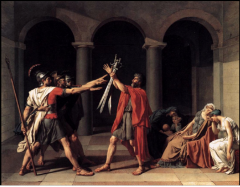
|
Jacques-Louis David, Oath of the horatii, 1784 history painting, very educational, didactic neoclassisim comissioned bu louis the 16th while he was king to demonstrate monarchial reform to show he was taking the issues seriously commisioned artworks to show he was serious about reform talkes to david and gives him specific story, and asks for specific point in narrative neoclassical in style, looks like ancient rome, clothing and architecture action is all in forfront, back ground dissapears event in ancient rome, where rome is in war with elba, to spare blood shed of people in two areas take three brothers from rome and three from alba and they can fight until the last one stands the winner is the winner of the war the moment where the three brothers are swearing alegance to the father who holds the swords but really to the stare, for the notion of rome composition easlity split in thirds the women on the right are fallign over in grief woman is engaged to alba brother and her brother is fighiting for rome brothers are all strong and erect women are all falling over and have slumped posture gender connotations the moment louis the 16th wanted one of the horatii brothers survived. she comes back to find the sister crying over her fiance's death so he kills his sister, they go to court and the father protects the son saying that loyalty to the family is the most important the story the king wanted is of familial dedication like the king who has a right to rule due to his birthright the artist wants an oath to the people the artist kept it was rejected by the king the official critics didnt like the layout the unofficial critics liked it, and saw it as a call to arms, connected to political ideals of the moment david became a revolutionary painter |
|
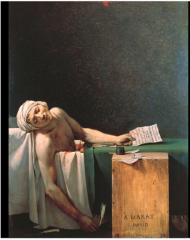
|
David Death of marat, 1793 jacobins come to power, david is assosiated with them marat was important in movement, david was called to the scene of his death, to sketch him and make it into a painting of martyrdome he is slumped over the bath, a board and cloth were there as a writing desk he had a skin affliction and would have to spend most of his timesoaking his skin would recieve visiters like this he was killed like this as a martyr wit ha turban around his head, halo like status of christ like figure letter from charlotte corday, pretending to be representing the people he argued for the killign of the king she seeked his audience and then killed him he has a quill like hes writing back, and the knife on the floor from his assasination christ like figure a martyr for the cause the jacoben killed 40 thousand people themselves a very bloody revolution the art was negotiating the politics of the time
|
|
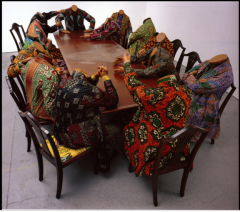
|
yinka shonibare, scramble for africa, 2003 quoting historical event, series of events 1880-1900 the scramble for africa as a historical movement a rapid colonization of africa by european forces almost all of africa colonized after this point colonized. about exploration and capitalism british dutch spanish french, looking to exploit and explore africa. for resources and legitimate trade to take place. trade before this was exporting slaves capitalism was trying to exploit natural resources, to establish legitimate trade to build wealth in europe for expansion of capitalism, a scramble for best trade routes water ways etc for best extraction of roots always headless for unclear identification to avoid idealizing the figures in bright costumes, a bunch of european figures rendered with darker skin over a map of europe colonialism, imperialism the colonial powers were sitting at a table deciding how to divy up africa, which is not entirely wrong historically meetings were infact held to discuss how everyone would be successful lyberia, and ethiopia were the only countries that remained free from european colonial control colonialism is an unequal set of power relations support is attempted to rally support, an attempt to justify their presence |
|
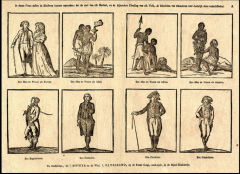
|
J Ratelband & J bouwer, The Peoples of the world, first published in amsterdam (1767-1779) theorists titled it, showed people from asia, africa and the americas, shown as very different from their european counter parts. dutch english spanish french, who are in their finery. the image shows a justification of the inequity contact* touch between two people first contact a meeting where two peoples didnt previously have knowledge of eachother described later by more powerful group as a time of discovery visual culture participates in the visual imagination of what colonialism means for the europeans. a representation by europeans to europeans, of these other people, not the truth
|
|
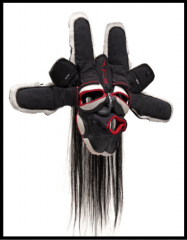
|
Brian jungen, prototype of new understanding #5 1999
post colonialism is swiss and dansay first nations group, lives in vancouve part time parents died in fire at 7, grew up in switzerland and montreal and returned to vancouver attending vancouver simple formal and stylistic composition works exploring danzay herritage in border between bc and alberta the rockies 1000 danzay live in bc and 2000 in alberta there have been many treaties and agreements of trade around peace river stylization of a mask from hand sewn parts of nike shoes. not hiding materiality of it, identifiable shoes. intrest in sports was using sports acsessories to make things, colour pallet conencted to first nation things, red white black, also interested in the apropriation of native culture in sports contact assimilation and simply manipulating air jordan shoes, cultural apropriation and shoes, consumer artifact and authentic native artifact. after contact no identity is pure or untroubled. how do we negotiate the mixing of identity and apropriation.
|
|
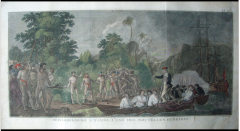
|
The landing of captain cook at tanna, one of the new hebrides from cook's second voyage, 1790 colonialism, the other, navigator explorer cartographer, captain cook explorers would have teams of people, scientists, early anthropologists, artists, to draw everything, to bring back to europe, made into print for upper class public cook was one of first to bring artists with him first to measure longitude successfully. first thing published are journals, travel logs, to gain support for future trips moment of contact where cook is landing at tana an island, with all his team the aboriginal people have hands up in greeting the coding, temptuouse sea, the english are shown in risk taking positions, the colonized are more conected to the land. naked vs clothed coding explointing notions of exploration and concquest first contact, the meeting of two cultures who are previously unaware of eachother coded as discovery, brings a lot of concequences. generally society with more technology has the advantage the english and spanish first bring small pox when they make contact, very devistating as the indiginous people had no immunity. germ warfare general grant one of first to participate in germ warfare gave natives who he wanted to move west blankets that were infected with small pox unintended shifted power relations culttural shifts, loss of language and cultural production after moment of contact things will never be the same, it changes everything, can never go back in time and un know |
|
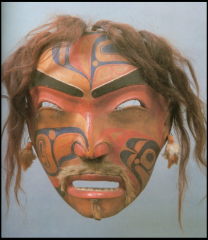
|
Tsimshian mask C1875 north west coast similar to objects taken by cook situated in western museums cultural appropriation began from this decontextualized objects. some european artists celebrated and adopt visual strategies. one object is removed from context and placed in enviomnent mask connected with dance and movement warefare ritual family lineage, ceremony could serve a commemorate service to ancestores, in potlaches, which were banned for quite some time by the colonial governments masks had living moving purpose in europe are in ethnographic museums, no movement and objectified passed between culture through trade and warfare wooden mask with paint hair and fur the wearer can show eyes and mouth tattoos and face shows it is troubled in some way anguish shown taken illegally apropriation and exploration
|
|
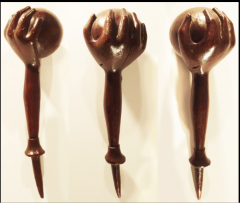
|
Ceremonial Club, nuu-chah-nulth (vancouver island) 1778
connection to bc and captain cook only object voyage brought back to england, last one held in a private collection, bought by micheal audane 2 years ago and donated to museum of anthropology a club in shape of an arm with a hand holding a sphere, carved using stone tools or possily sharppend muscle tools 1778 given to cool made before contact with europeans style changed after that contact 827000 bought by audaine and donated to the museum of anthropology
|
|
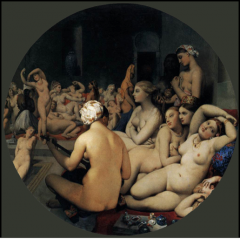
|
Contact orientalism colonialism jean-auguste-dominique ingres, tukish bath 1856-63 painted at 82 is very proud of this fact and notes his age on the painting "painted by ingres at age 82" it was square, cut by artist to be circular to fit into the wall mount area of the buyer, a tondo showing neude women in a harem, in a sultains house hold wives, mistresses concubines, languish around in most sexually available ways for a titilation of a viewing public, making available the fantasy this has a coding of uncivilized peoples. the artist didnt meant to promote the power relations, they are simply part of a context where the ideologies are not contested in any way. naturalised assumptions of the day, the artist doesnt recognise that they are furthuring the thoughts orientalism was handed back, the patron napolean 3 said his wife doesnt like it. it was then sold much later to a turkish collectors erotic collector.
|
|

|
Pietro-antonio martini, exhibition at the salon louvre museum 1787
meaning in art the way we acru value to it the word exhibition means a public display of works of art, science design products, where display is made public starting in the 18th century PUBLIC factor determins or underlines the exhibition. objects coming back to europe are put on view, how objects enter public discourse how do we participate in acruing symbolic value a salon exchibit, the academy systems set up exhibitions for members through yearly or other yearly salon exhibits this is the kind of display you would see images from ceiling to floor, very political who gets the best space on the wall the area at the bottom where people are turned and talking about the work critiques present writing about the works various classes mixing often free and open to the public mixings across social classes and genders allowing in some ways for free discourse of works on view
|
|
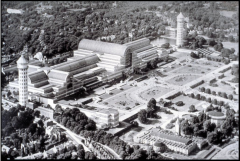
|
joseph paxton, the crystal palace, london, 1851 structure entirely of glass with steel structure worlds fair key word expsition/ expo one of the first world fairs broad based expositions, highly desireable in 19th c demosntrates the justification of colonial intersts positioned home country as privlidged or rightouse group the scheme of the building designed by joseph paxton a landscape architect and gardener, based on contemporary green houses cast plate glass method technologies, cheap but durable plate glass clad entire building astonished viewers, as it was so light inside how it got its name the crystal pallace 564meters long 39 meters high 100,000 exhibitions housed in the building from 20 thousand domestic and foreign exhibitors 6 mil people saw the show 43 thousand ppl daily 18million pounds revinew lots of money made organized by henry cole and prince albert queen victorias husband. grew into very large exhibition half of work was presented by great brittan or its colonisers interior designer owen jones was first designer to think about program in relation to movement of people in space used banners and markers to show where countries would be displaying things also used colour coding to help the viewer navigate the space made quite a few interpretive guides to help the viewer CRAFT
|
|
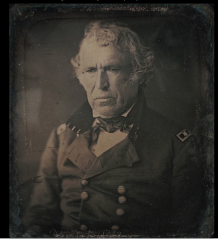
|
mathew brady, portrait of zachary taylor C 1846-9 exhibited at great exposition demonstrated new ideas. a new invention or new technologies in 1839, how to "fix" images photography and visual culture comes to be, brings up tensions around other kinds of media 12th us president, on office for 2 years was a general in the mexican american war photo rivals portrait painting is it a science or technology, or is it an art form if it is an artform what makes it specific and unique, how does it rival painting the begnining of 20th century where it is recognized as an artform, before it was a technology. daguerrotype key word daguerre and henry fox talbot, both had the technologies independently at the same time figure downcast to have something to focus on with out moving a very sensetive process |
|
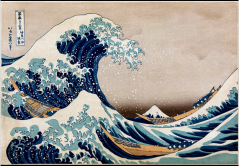
|
katsushika hokusai, the great wave off kanazawa, 1823-39 36 views of fuji wave is swallowing the boat, as fuji is so far in the background the stylization of the wave looks like tentacles thewater colour and the spray is stylized the move away from realism was very influential to western art became 46 views of fuji. to promote tourism, nationalistic rhetoric, to see japanese sites and not sites far away NATIONALISM found a liberation from academic conventions and values, the space is flattened out. the mountain is portrayd in the back in diminutive way, the images are all in forground, the style is not of the trained perspectives |
|
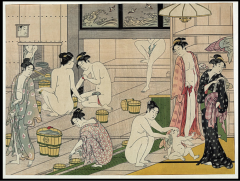
|
torii kiyonaga interior of a bath-house c 1800 emphasis on the figure and contour line the prints ar the ukiyo-e prints a print form highly influential for european prints they lacked perspective and shadow lots of compositional freedome most important figures to the side pictures of the floating world means ukiyo-e pritns living only for the moments, a quote of floating and happiness dreamyness, the explination of floating world playful images, for european viewers it was exciting and different the female form is rendered with high focus on contour lines and bright patterning and colours domestic scene mother cleans child women clean themselves behind are legs of a mn who is spying on them, it is playful and light hearted lack of perspective and shadow, flat areas of colour and freedom of composition. very influention to european artists |

